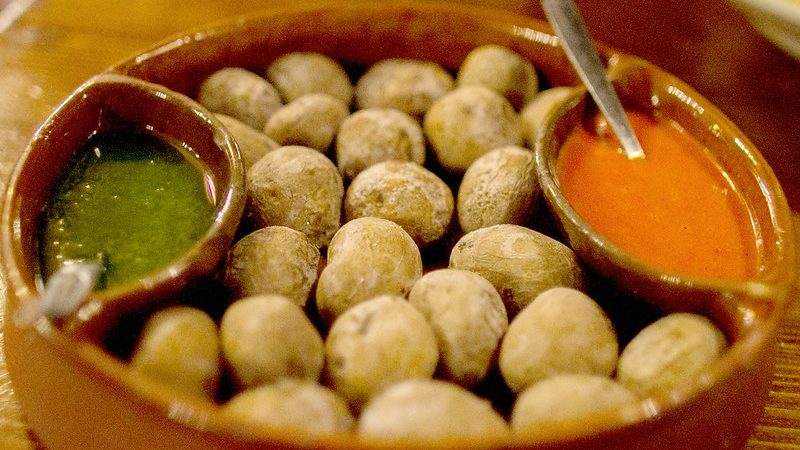When coming to the Canary Islands, people usually expect to find paella and patatas bravas at every restaurant. But these are typical Spanish dishes, from the peninsula; the real Canarian food is a type of their own! Read more and get to know the real Canarian food! Did you also know that a lot of restaurants in Gran Canaria offer a very cheap menu del día?
Papas arrugadas con mojo
Papas arrugadas means wrinkly potatoes and is a very traditional dish in the Canary Islands. The small potatoes are first cleaned and then boiled in very salty water. Back in the day, the potatoes would be boiled in seawater, but these days chefs just add a generous amount of salt to the water. After boiling the papas they are left briefly in the pot to dry off and to give them their typical wrinkled and salty layer. The papas arrugadas are then served with mojo rojo and sometimes also with mojo verde. You can’t leave the island without trying this typical Canarian food!
Mojo rojo y mojo verde
Traditionally served with papas arrugadas but mojo goes great with other snacks too. Bread, cheese, meat, fish, just try it! Mojo rojo is made from olive oil, red peppers, garlic, vinegar and cumin, though every restaurant will have its own variation. Generally speaking, it’s not a really spicy sauce. In the mojo verde the red peppers are replaced with cilantro.
Ropa Vieja
Ropa vieja literally translates to old clothes, since it was traditionally made from leftovers. It’s probably the most popular dish in the Canary Islands and you can find it at every Canarian restaurant. Ropa vieja is a stew made with meat, vegetables, potatoes and chickpeas and is a perfect dish for when it’s a bit colder. Usually it’s eaten during lunch as the main dish.
Almogrote
Almogrote is native to the island of La Gomera but also very popular in Gran Canaria. It’s a soft paste, made from hard cheese, peppers, olive oil and garlic and typically eaten on toast. Depending on how well it’s blended, it can be very smooth or a bith chunky. I personally love the almogrote at Bodegón Pachichi.
Gofio
Gofio is native to Tenerife but can also be found on other Canary Islands. It’s a flour made from roasted gains of wheat, maize or corn and is used in a (surprisingly) variety of dishes. Gofio became popular during the Spanish Civil War, since this superfood is packed with healthy and essential vitamins, fiber and proteins.
The most popular dish that is made with gofio is gofio escaldado, a fine puree covered in a meat or fish broth, with big chunks of red onion on top to use as a spoon. Gofio is also served with soups, sauces, ice cream and desserts. You’ll probably find the gofio mousse on the menu.
Rancho Canario
This hearty thick soup is made with potatoes, vegetables, meat, chick peas, lard and thick noodles and is usually served as a starter. It’s quite thick and has more the consistency of a stew. Every island and restaurant will make their rancho canario slightly different.
Queso Canario
Cheese is served in every restaurant and all (farmers) markets sell a big variety of locally produced cheeses. Queso de cabra, goat cheese, is definitely the most popular cheese on the islands. It’s popular to order grilled goat cheese, with a bit of mojo verde or mojo rojo on top.
The Mercado Central in Las Palmas de Gran Canaria, the market of San Mateo, de Mercadillo de Teror and Recova de Gáldar are all good places to buy Canarian and artisan cheeses.
Queso Palmero is a type of goat cheese, produced in La Palma and is definitely recommended to try, especially if you like smoked cheeses. Queso Majorero is made on the island of Fuerteventura and has a milky, nutty flavour. Majorero can be used to make almogrote. Flor de guía is locally produced in Gran Canaria (Galdar, Moya and Santa María de Guía) and is traditionally made from sheep milk. It’s allowed though to add up to maximum 40% of cow’s milk.
Piementos de Padrón
The green piementos de Padrón originated in Galicia, the south west of Spain, in the municipality of Padrón, but are now also very popular in the Canary Islands. The small green peppers are fried in olive oil untill the skin starts to blister and then covered in coarse salt. Usually the taste of the peppers is mild, though there is a Galician saying Os pementos de Padrón, uns pican e outros non which poetically translates into Padrón peppers, some are hot, some are not.
Follow @liveituplaspalmas on Instagram
Are You A Remote Worker, Local Professional, Immigrant, Digital Nomad Or Expat In Gran Canaria?
Or do you simply want to connect with an awesome international community? Join here! Besides a welcoming community with lots of information and events, you’ll also get 10% discount on surf lessons, 10% discount on diving and access to more exclusive deals!
